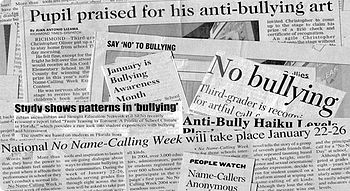 |
| (Photo credit: Wikipedia) |
In the first installment of this series, I explained the early cases laying the conceptual groundwork for the proposition that failure to react to bullying can constitute a denial of FAPE under IDEA. In later installments, I have discussed the seminal decision of TK & SK ex rel LK v. New York City Dept of Educ 779 F.Supp.2d 289, 56 IDELR 228 (E.D.N.Y.4/25/2011). This case is important not just because it analyzes special education law principles involving bullying, but also because it provides a thorough review of the social science literature on bullying. You should read this case and you can do so here. (NOTE: What follows is a discussion of TK I. Please note that we have subsequently done a post on the District Court's decision on the appeal of the SRO decision after the court's remand, or TK II. You can read that post here. TK I remains good law.) #bullying
In the meantime, here is more from the TK court...these are not my words:
In the meantime, here is more from the TK court...these are not my words:
F. Effects on Children
3. Bystander
Bullies typically operate in front of a crowd, and the students who act as onlookers do not escape the effects of bullying. These students, who often watch, or even step away from the bullying actions, are more likely to feel powerless and to be fearful at school. Macklem, supra, at 91-92. Bystanders feel as though they are incapable of controlling the situation, and thus are not themselves safe. Id. at 91.
Students may go along with the group in the bullying behavior out of fear that if they were to speak up they might lose their space within the peer group and open themselves up to be the next victim.Id. As time goes on, if bullying persists at a high level, bystanders become desensitized and are less willing to step in to prevent the harassment. Id.











No comments:
Post a Comment